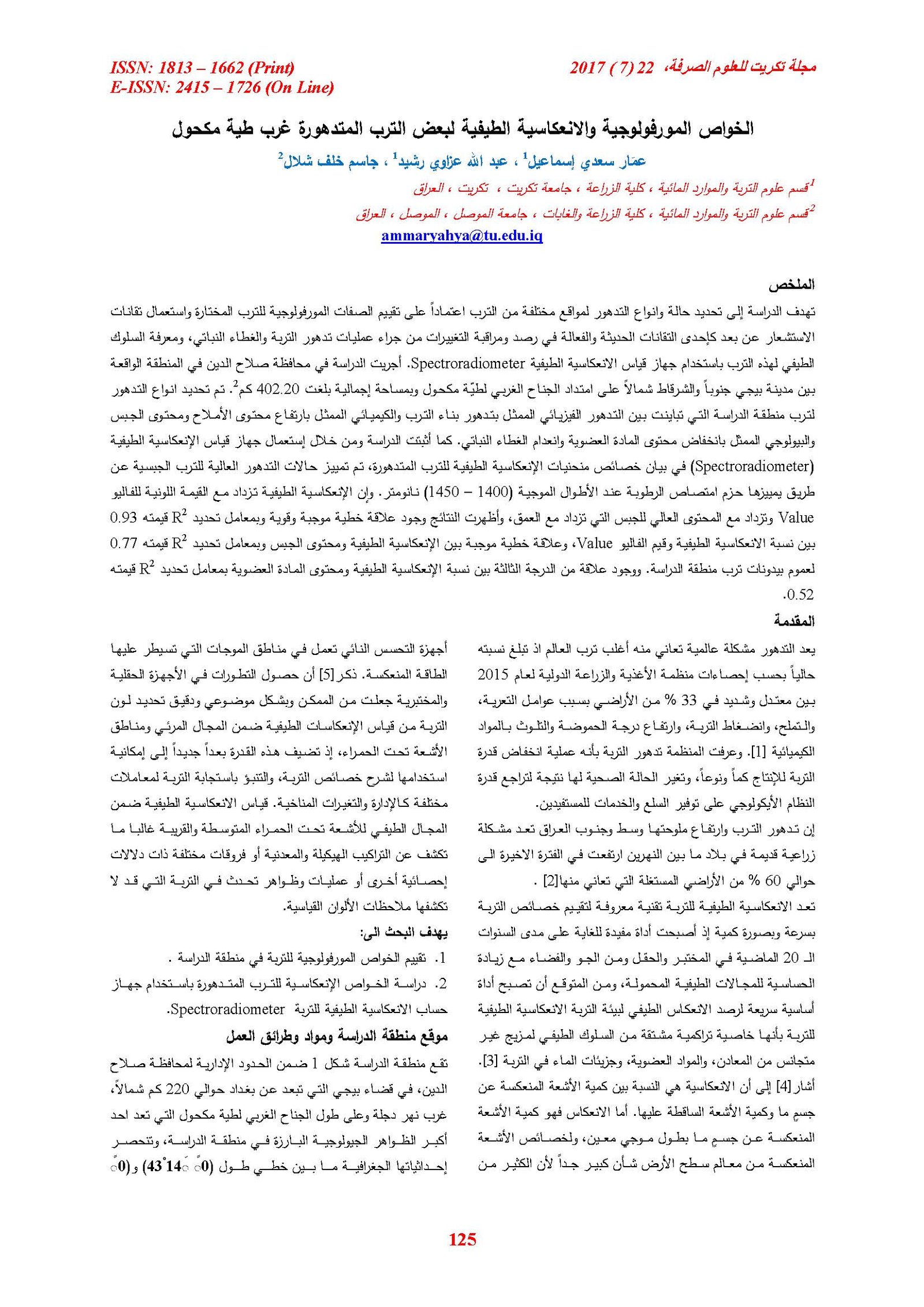Morphological characteristics and spectral reflectivity of some degraded soils west Fold Makhoul
Main Article Content
Abstract
The study aim to determine the status and the types of degradation in different sites, depending on the interest of the morphological characteristics Evaluation of the selected Soils and using the Remote Sensing Thechniques as a modern and efficient technologies in monitoring and controlling changes as a result of soil degradation and vegetation and knowledge of the spectral behavior of these soils using a measuring device reflectivity spectral Spectroradiometer. The study was conducted in the province of Salah Alddin in the area between the city of Baiji, and Sharqat that represent the western flank of Makhoul fold, the Total area was to 402.20 km2. It has been identified types of Degradation of soils study, which varied between physical degradation District Representative Degradation at Soil Structure build soils and chemical Representative high content of salts and gypsum content and biological Representative down the organic matter content and lack of vegetation. The study also demonstrated through the use of Spectral Reflectance dvice (Spectroradiometer) to show properties of Spectral reflectance curves of degraded Soil, and characterized by a high degree of gypsum soils with situations of deterioration as a result of high gypsum content by distinguished absorb moisture packs at wavelengths (1400-1450) nm. A reflectance spectral increases with the color value of the Value and increases with higher content of Gypsum, which increases with depth, The results showed a linear relationship was positive and strong, a factor determining R2 value of 0.93 between the percentage of reflectivity and spectral values, linear relationship positive between reflectance and spectral content of gypsum, a factor determining R2 worth 0.77 Pan Pedons soils study area. And the existence of a relationship between the third-degree reflectivity ratio of the spectral content of organic matter by a factor of determining R2 value of 0.52
Article Details

This work is licensed under a Creative Commons Attribution 4.0 International License.
Tikrit Journal of Pure Science is licensed under the Creative Commons Attribution 4.0 International License, which allows users to copy, create extracts, abstracts, and new works from the article, alter and revise the article, and make commercial use of the article (including reuse and/or resale of the article by commercial entities), provided the user gives appropriate credit (with a link to the formal publication through the relevant DOI), provides a link to the license, indicates if changes were made, and the licensor is not represented as endorsing the use made of the work. The authors hold the copyright for their published work on the Tikrit J. Pure Sci. website, while Tikrit J. Pure Sci. is responsible for appreciate citation of their work, which is released under CC-BY-4.0, enabling the unrestricted use, distribution, and reproduction of an article in any medium, provided that the original work is properly cited.
References
2. FAO. (2011). Country Pasture / Forage Resource Profiles : Iraq. FAO, Rome, Italy, P.34.
3. Ben Dor, Eyal., Ong, Cindy., and Lua, Ian. C.(2015). Reflectance Measurements of Soils in the Laboratory: Standard and Protocols. Geoderma,112-124.
5. Stoner, E. R. (1979). Atlas of Soil Reflectance Properties. Result Bull. 962. West Lafayette, IN; Purdue University Agriculture Experiment Station.
6. Soil Survey Staff.(1993). Soil Survey Manual, USDA. Handbook no 18,US Government printing office Washington.D.C.20402.
9. Kilmer, V.J., and Alexander, L.T. (1949). Method of making Mechanical Analysis of Soils. Soil.Sci.68:15-24.
10. Black, C.A. (1965). Methods of Soil Analysis. Amer. Sco of Agron.No.9 part 2 Madson Wisconsin (U.S.A).
11. Richards, L.A.(Ed).(1954). Dignosis and Imporvement of Saline and Alkali Soils. Agriculture Handbook 60.USDA.
12. Savant, N. K. (1994). Simplified Methylone Blue Method for Rapid Determination of CEC of Mineral Soil. Soil Sci. Plant. Anal.25:3356-3364p.
14. Jackson, M.L. (1958). Soil chemical Analaysis. Prentic- Hall Inc. Engle wood, Cliffs, N.J.
15. Makhamreh. Z.(2006). Evaluation of Soil Quality and Development Stage Using Spectral Reflectance
of Soils: Case Study in Easternmideterranean Region. Proceedings of the International Conference. Hamburg, Germany. Department of Geography- Faculty of Humanities and Social Sciences- University of Jordan.
16. Ben-Dor, E.,A. Pimstein, and G. Noteco. (2010). Variation and Stability of Soil Reflectance Measurments with Different condition. Department of Geography of Geography and human Environment, P.O.Box1.39040.
18. Al Ansari., Nadhir A. (1972). Geology of the Southern of Jabal Makhul (Quadrangles NI-38-0196). M.Sc. Thesis College of Science, University of Baghdad, Iraq.
19. Gile, L. H. (1961). Classification of Ca- horizon of Desert Region, New Mexico. Soil Sci. Soc. Am. Proc.30:52-61.
22. Al Zubaidi, A.H.(1974). Chemical Characteristics of some Iraqi Soils Pedology. (19) 1:65-148.
23. Dregne, H. E. (1976). Soils of Arid Regions. Amsterdam, Elsevier Science. Puplising Company Amsterdam, Oxford New York.
25. FAO. (1973). Calcareous Soils Iraq, Bull. No.21, FAO. Rome.
26. Sayegh, A. H., N. A. Khan, P. Khan and J. Ryan. (1978). Factory Affecting Gypsum and Cations Exchange Capacity Determination in Gypsiferous Sols . Soil Sci. 125:294-300.
29. Mulder, M.A. (1987). Remote Sensing in Soil Science, 15, Elseverir, Amusterdam,379.
30. Escadafal, R., M. C. Girared., and D. Courant. (1989). Munsell Soil Color and Soil Reflectance in the Visible Spectral Bands of Landsat MSS and TM data. Remote Sensing of Environment. 27:37- 46.
